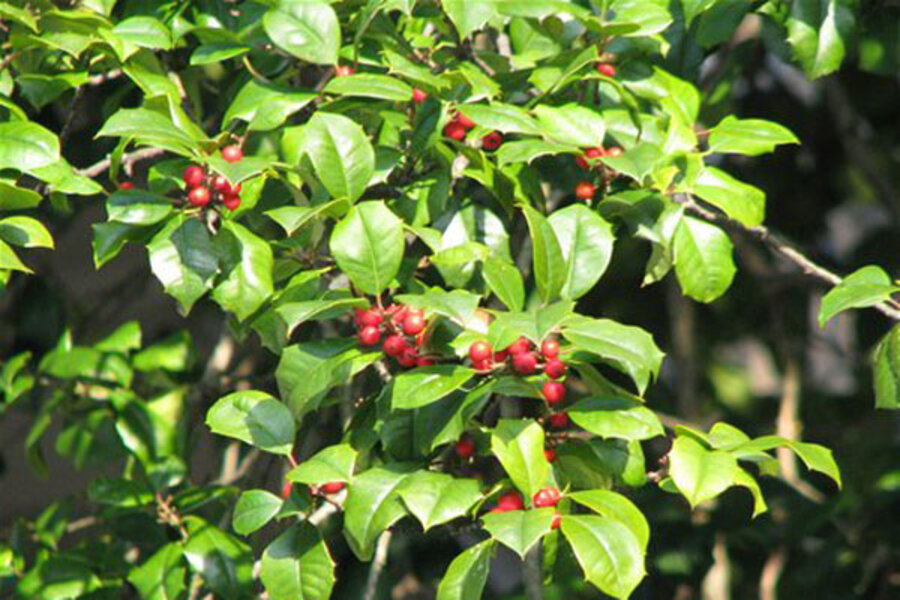Red and green in the garden
Loading...
The darkest time of year, when days are shortest and the sun hangs lowest in the sky, is surely an odd time to pick for celebration. Then again, what better way to show faith in the continuity of life?
A sprig of greenery does it, or a whole tree awash in greenery, either one flouting the apparent dead stillness of winter. Add a few red berries and the scene is complete, for in berries lie seeds of life to come. Plus, red and green look pretty together.
We all know what plant first comes to mind when thinking of evergreen leaves and red berries, but others exist. Admittedly there are fewer when you head into colder climes. But just about everywhere, a few evergreens sport brightly colored fruits in winter.
Evergreenery on the ground
For starters, drop your eyes to ground level while walking in the woods. You might come upon wintergreen, creeping along. No reason this plant couldn't be part of your home landscape, preferably a naturalistic one.
Wintergreen's leaves taste like — duh — wintergreen, and the red fruits taste like teaberry, but you don't have to eat the plant to appreciate it. It looks delicate, but is tough if given a site to its liking, which means dappled shade or an east-facing exposure and an acidic soil rich in humus. Provide both acidity and humus by mixing plenty of peat moss into the soil at the planting site.
You're unlikely to come upon two other ground-hugging natives with evergreen leaves and colorful fruits because their native habitats are more restricted:
Cranberry is one, and it grows in bogs. In your backyard, it is possible to grow cranberry without a bog — just provide the same site conditions recommended for wintergreen, be heavy-handed with the peat moss, and don't let the ground dry out.
The same growing conditions apply to the next plant, too — lingonberry. Actually, it's an even better choice than cranberry, because although cranberry's leaves stay on the plant all winter, their color turns purplish in cold weather. Lingonberry keeps its perky green color all year round, and its fruits — in case you want to eat them — taste better.
Colorful shrubs for winter
Moving up off ground level, wintercreeper euonymous provides colorful berries and evergreen leaves. Without something on which to climb, this vining plant stays at ground level, so grow it near a wall or large tree, either of which will also provide some needed protection in winter. The pink fruits split open to reveal a seed wearing an orange coat.
Getting up off the ground by themselves are shrubby pyracantha, leatherleaf viburnum, and yew. Don't be surprised if leatherleaf viburnum's fruits are not red, for they turn that color just briefly during their transition from yellow to black.
And then we come to the plant we all thought of first: holly. Like the other evergreens mentioned, holly fares best if protected in winter. That doesn't mean swathing it in burlap, because then you wouldn't see the green leaves and colorful fruits.
Protect any evergreen in winter with forethought, before it is even planted, by choosing the site carefully. Evergreen leaves, especially broadleaf as opposed to needled ones, easily burn when water is sucked from them by the combination of bright sunlight, often intensified as reflected off snow, and cold, dry winds. So the farther north these plants are grown, the more they need an east- or — next best — west-facing exposure where wind is attenuated by your home, garage, a fence or a wall.
Also, choose species or varieties of evergreens adapted to the local climate: American holly for regions with cold winters, English holly for regions with mild winters.
Editor’s note: For more on gardening, see the Monitor’s main gardening page, which offers articles on many gardening topics. Also, check out our blog archive and our RSS feed. You may want to visit Gardening With the Monitor on Flickr. Take part in the discussions and get answers to your gardening questions. If you join the group (it’s free), you can upload your garden photos and enter our contests.





